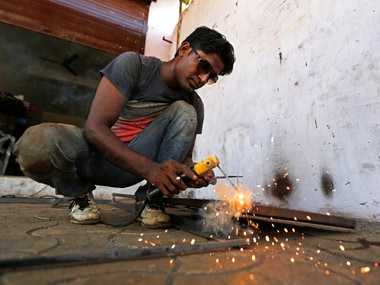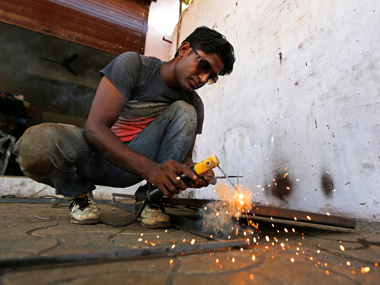Indian economy has been the fastest growing economy, as per major multilateral institutions. The gross domestic products (GDP) growth in the last five years have been resilient at an average of 7.5 percent during 2014-15 and 2018-19. However, y-o-y GDP growth moderated to 6.8 percent in 2018-19 from 7.2 percent in 2017-18, marking it its second consecutive year of slowdown . Supply side factors such as slowdown in agriculture as well as a stagnant industrial sector have been cited for the slower than expected growth.
Though manufacturing forms an integral part of the industrial sector, its sectoral growth has ranged around 7 percent and its share in GDP has stagnated to around 16 percent. Comparing poorly with peers such as Indonesia (20 percent), Malaysia (22 percent), Thailand (27 percent) and China (29 percent), the performance of India’s manufacturing sector over the past few years has been dismal.
The
Index of Industrial Production (IIP) numbers have also been in line with this slowing growth, declining from 4.4 percent in 2017-18 to 3.6 percent during 2018-19. This decline was mainly due to fall in manufacturing activity, which carries the highest weight of 77.6 percent in terms of sectoral classification in the IIP. [caption id=“attachment_4138761” align=“alignleft” width=“380”]
 India has not been able to pump up its manufacturing of late. Reuters[/caption] At the global level as well, if we look at the top trading countries of manufactures, India features among the major importers of manufactures, with its share in global imports increasing from 0.5 percent in 2000 to 1.8 percent in 2018. While India’s peers like China (17.6 percent of global manufacturing exports and 9.4 percent of global manufacturing imports), South Korea (4.0 percent of exports and 2.3 percent of imports), Mexico (2.8 percent of exports vis-à-vis 2.6 percent of imports), and Singapore (2.3 percent of exports vis-à-vis 1.8 percent of imports) feature in both, major global exporters and importers in terms of manufacturing. India is a net importer of manufactured goods. India’s manufacturing merchandise trade deficit peaked in 2018-19 at $74.9 billion, in line with the total merchandise trade deficit of $183.7 billion in 2018-19. This may not necessarily be implied as a detriment to growth, provided it is supplemented by better integration with global value chains. On the other hand, high input costs can exacerbate the sector. The uptrend in wholesale price index (WPI) inflation from 2.7 percent in 2017-18 to 4.3 percent in 2018-19, mainly driven by the manufacturing, would eventually translate into higher output prices. Gross Capital Formation (GCF), a measure for investment expenditure, in manufacturing has also remained stagnant with GCF in manufacturing being around 17 percent. The manufacturing GCF growth peaked at 11.4 percent in 2015-16, following which it eased to 1.3 percent in 2016-17 and increased to 8.0 percent in 2017-18. Modest increase in investments is also a major supply bottleneck withholding India’s manufacturing sector. Credit deployment to the manufacturing sector has also not been very encouraging. RBI’s industry-wise credit deployment in 2018-19 shows that’s apart from infrastructure (with a growth of 18.5 percent in credit in 2018-19), chemical and its products (17.5 percent) and engineering sectors (8.6 percent), credit offtake in other sectors has not shown much growth. In fact, in sectors such as basic metal and its products (declined by 10.7 percent), textiles (-3 percent), petroleum, coal products & fuels (-3.1 percent), credit deployment has declined. To put this in perspective, the sectoral composition of the Indian manufacturing industry as per the United Nations Industrial Development Organization (UNIDO) is chemical and related products (19 percent of total manufacturing value added in 2017), coke, refined petroleum and nuclear fuel (13.6 percent), food and beverages (8.7 percent), motor vehicles, trailers and semi-trailers (8.6 percent), basic metals (7.9 percent) and textiles and wearing apparel (7.8 percent). Industry-wise deployment of bank credit *Includes beverages and tobacco Source: RBI (data for 2018-19) Capacity utilisation (CU) in the manufacturing sector, on the other hand, showed some signs of optimism, with CU at the aggregate level of 76.1 percent in Q4:2018-19, compared to 75.2% in Q4: 2017-18. CU is measured by the order books, inventory and capacity utilisation survey (OBICUS) of the Reserve Bank of India’s (RBI). The pickup in CU indicates the recovery in demand for new capital investments. Recognising the importance of a strong manufacturing sector and its implications on employment generation, there were a slew of policy measures announced since 2014, including the Make in India, Skill India, liberalization of FDI norms for select sectors, National Capital Goods Policy 2016, and National Policy on Electronics 2019, among others. India’s progress in terms of becoming a global manufacturing base has been slower than expected, despite these policy measures, and having a strong labour force, steady supply base and relatively better access to natural resources. Further, given the present global economic conditions and slump in India’s key sectors including automobiles and fast-moving consumer goods (FMCG), India’s target of attaining a manufacturing share of 25 percent of GDP in 2022, calls for more than just a policy overhaul. There is a need for creating sufficient and affordable liquidity in the system, especially in the manufacturing sector. With the RBI softening its policy rates for the fourth consecutive time in 2019, and Banks expected to pass on these rate reductions, there is hope for uptick in credit flow to key manufacturing industries, especially the ones with an export orientation. Further, there is an increasing need for increase in research and development expenditure in the manufacturing of medium and high technology products. According to UNIDO, India’s resource based manufacturing accounts for the highest share in manufacturing value added (36.7 percent) followed by low technology intensive products (29.5 percent), medium technology (24.7 percent) and high technology (9.2 percent) in 2017. ( The writer is an economist with Export-Import Bank of India)


)
)
)
)
)
)
)
)
)



